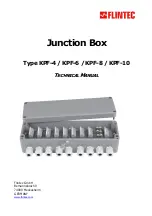
S
UMMARY OF
I
MPORTANT
S
ERVICE
H
INTS
At each re-calibration or repair following checks or actions have to be done:
1. All bottom parts of the cable glands are sealed to the housing with some gasket. You have to check
the existence and the condition of these gaskets, the gaskets have to be replaced if required.
2. You have to check all bottom parts of the cable glands for a firm seat in the housing.
(Recommendation: use a 12-point ring spanner with a cut-out and metric size 19 mm, if the cable are
already installed).
3. All cable gland nuts must be tightened. A cable gland nut is tightened correctly if the cable gland
constricts the cable jacket (not the shrink tube!) significantly! The cables must not run sloped in the
cable glands.
4. Unused cable inlets must be closed by a blind plug. If a cable gland nut is correctly tightened the
sealing part of the cable gland must constrict the blind plug significantly!
5. An eventually existing pressure compensating valve has to be removed. The corresponding hole
must be closed by a blind plug and a gasket.
6. The earth screw must be electrically connected with protective earth (potential equalisation).
For doing this only the upper nut should be loosened and tightened again. The lower nut (= counter
nut) and the earth screw with washer must not be rotated or loosened – the gasket is bonded!
If loosened by accident the earth screw must be re-inserted and locked with some Loctite.
7. Before you will close the junction box you must check the cover and the cover sealing for any dirt or
damage. Replace the cover sealing if required, otherwise a proper sealing is not assured.
Generally you have to use the red sealing made of silicone. You can improve the quality of this
silicone sealing (it must be the red one!) by using a suitable grease (e.g. sanitary grease for fittings).
8. Before you close the cover again you have to place 2 new dry tablets within the junction box.
9. The cover screws always have to be tightened crosswise and equally unless the cover is attached to
the junction box.
10. Generally the inside of the junction box must be totally dry before you can close the cover
Junction Box Type KPF – Technical Manual, Rev. 1.11 July 2008
Page 7 of 8


























